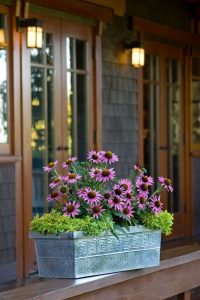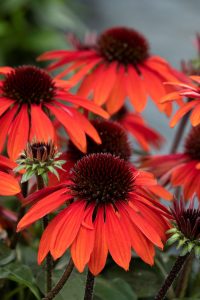by Ken Lain, the mountain gardener

Vibrant blooms on upright stems top this sturdy, compact plant. A fuss-free, cheerful choice for a sunny, easy-care low summer border. Drought tolerant and hardy, with prolific flowering over an exceptionally long season. These wildflowers are both heat and drought-resistant, easy to grow, bloom for months, make great cut flowers, and attract birds and pollinators.
Coneflower comes in glorious shades of pink, orange, yellow, red, and chartreuse and a range of flower forms—standard shuttlecock to horizontal ruffs to doubles with a powder-puff center.
Botanical name: Echinacea
Common names: Coneflowers
Growing Zones: Zones 3 to 9
Size: 2-3′ feet tall x 1-2 feet wide
Light Needs: 6+ hours for best flowers
Water Needs: Once established, water occasionally; more in extreme heat.
Bloom time: June through Autumn
Leaves: Thick, leathery and sturdy hunter green
Flower color: Purple, pink, red, orange, white, yellow, even green varieties at Watters.
Problems: Resistant pests, disease, and animals like deer, elk, and javelina.
Wildlife: Attracts birds, primarily through winter.
Special features: Easy Care, Fast Growing, Pet Friendly, Waterwise
Companion Plants: Pampas Grass, Honeysuckle, Russian Sage, Gaillardia
Animal Resistant
Their spiny centers and strong aroma deter deer.
Birds and Pollinators
If you want to enjoy butterflies and songbirds in the garden plant coneflowers. Month during the summer and fall, the blooms and seed heads attract a multitude of winged beauties. Each flower offers a buffet table for butterflies. Other pollinators, such as honeybees and hummingbirds, visit this fantastic flower.
HOW TO PLANT
When to plant: This perennial flower starts to arrive at Watters Garden Center in late spring through Autumn in most colors.
Where to plant: Echinacea should be planted in 6+ of sunlight during the growing season. Less than this, the stems flop over, and the foliage is susceptible to powdery mildew.
How to plant: Dig a hole twice as wide as the pot and deep enough so that the rootball will be level with the top of the soil.
Water: Regular watering of about an inch per week starting in April through October. A 2″ layer of Watters Premium Mulch added in the spring over the rootzone greatly reduces needed water.
Pruning: Deadheading old flowers off the plant to stimulate new flowers to form. Many of the new varieties do this on their own and keep producing without snipping off spent blooms. Once your coneflower has finished blooming in November, the entire plant can be cut back to ground level. If you prefer to leave the dried seed heads, it can be cut down in March.
.
Soil: Average, well-drained garden soil.
Amendments & fertilizer: A 2″ layer of Watters Premium Mulch added in the spring over the rootzone significantly reduces needed water. Feed twice per month during the growing season with Watters Flowers Power For amazing nonstop blooms.
Propagation: Divide clumps when crowded, about every 4 years. If spent flowers are left intact, they will reseed with little effort on your part. Deadheading can help to control this. Some gardeners choose a middle ground and collect the seeds and plant them in carefully selected spots for the following season.

Diseases and pests: One problem worth noting in Echinacea is “aster yellows,” a virus-like illness caused by a phytoplasma. Symptoms are deformed flowers, sometimes with weird tufts in the cones, and yellow leaves with green veins. The organism is spread by sap-sucking insects like leafhoppers, and can also be spread on pruners during deadheading. There’s no cure, so once you notice a plant is infected, dig it up immediately and throw it away. They can also be bothered by leaf miners, powdery mildew, bacterial spots, gray mold, vine weevils, and Japanese beetles.
CONEFLOWERS FOUND @ WATTERS GARDEN CENTER
Echinacea purpurea’ Razzmatazz’
Zones: 3-9
Height/Spread: 2 to 2-1/2 feet tall, 1-1/2 to 2 feet wide
Exposure: Full sun to partial shade
Bloom Time: June to August
Color: Rose pink. A circlet of short pink petals is topped with a darker pink puff, reminiscent of anemone dahlias.
Echinacea Lakota Fire
Zones: 4-8
Height/Spread: 12 to 16 inches tall, 16 to 18 inches wide
Exposure: Full sun to partial shade
Bloom Time: Summer through fall
Color: Shades of red. Incredibly colorful flowers with mixed shades of red. Shorter stature, perfect for small spaces.
Echinacea Color Coded Yellow My Darling
Zones: 4-8
Height/Spread: 18 to 24 inches tall, 16 to 20 inches wide
Exposure: Full sun to partial shade
Bloom Time: Mid to late summer
Color: The rich yellow flowers fade to creamy yellow as they age.
Echinacea’ Green Jewel
Zones: 3-8
Height/Spread: 1-1/2 to 2 feet tall, 1 to 1-1/2 feet wide
Exposure: Full sun to partial shade
Bloom Time: May to August
Color: Light green rays with dark green cone. With large fragrant flowers that are 4 to 5 inches across, ‘Green Jewel’ grows to form a compact clump.
Echinacea Big Sky Sundown
Zones: 3-8
Height/Spread: 2-1/2 to 3 feet tall, 1 to 1-1/2 feet wide
Exposure: Full sun to partial shade
Bloom Time: June to August
Color: Russet orange rays with dark brown cone. Large flowers that are 4 to 5 inches across have a rose-like fragrance.
Echinacea Mango Meadowbrite
Zones: 4-9
Height/Spread: 2 to 3 feet tall and wide
Exposure: Full sun to partial shade
Bloom Time: June to August
Color: Yellow rays with brown cone.
Echinacea Maui Sunshine
Zones: 3-8
Height/Spread: 2 to 3 feet tall, 1-1/2 to 2-1/2 feet wide
Exposure: Full sun to partial shade
Bloom Time: June to August
Color: Yellow rays with an orange cone. Part of the Prairie Pillars collection, with long sturdy stems perfect for cut flowers, bright yellow rays mellow as they age.
Echinacea purpurea White Swan
Zones: 3-8
Height/Spread: 2 to 3 feet tall, 1 to 2 feet wide
Exposure: Full sun to partial shade
Bloom Time: June to August
Color: White rays with a copper cone. Somewhat shorter than the pink versions with a honey fragrance and reflexed white petals.
Echinacea Coral Reef
Zones: 3-8
Height/Spread: 2 to 3 feet tall, 1-1/2 to 2-1/2 feet wide
Exposure: Full sun to partial shade
Bloom Time: June to August
Color: Coral rays with dark coral red cone. Flowers are 3 to 4-inches across with tall, strong stems well-suited for cut-flowers.
Echinacea Tangerine Dream
Zones: 3-8
Height/Spread: 1-1/2 to 2 feet tall and wide
Exposure: Full sun to partial shade
Bloom Time: June to August
Color: Orange rays with dark brown cone. This coneflower holds its color for an exceptionally long time. Its large 4-inch flowers are honey-scented.
Echinacea purpurea Green Envy
Zones: 4-9
Height/Spread: 2 to 3 feet tall, 1-1/2 to 2 feet wide
Exposure: Full sun to partial shade
Bloom Time: July to September
Color: Pale green rays that change color to magenta from the center. Each recurving rose-pink ray petal is tipped with lime green, taking bicolor to the next level. Unusual cones are deep green with hints of brown, lime green, and purple.
Echinacea purpureaRazzmatazz
Zones: 3-9
Height/Spread: 2 to 2-1/2 feet tall, 1-1/2 to 2 feet wide
Exposure: Full sun to partial shade
Bloom Time: June to August
Color: Rose pink. A circlet of short pink petals is topped with a darker pink puff, reminiscent of anemone dahlias.
DESIGN TIPS
Mix early- and late-blooming varieties to enjoy colorful flowers up to 5 months. Early-bloomers like ‘Green Jewel’ and ‘Merlot’ start flowering in May, while cultivars such as ‘Fatal Attraction,’ ‘Pica Bella,’ and ‘Springbrook’s Crimson Star’ continue into September.
Russian sage, black-eyed Susan, Shasta daisy, phlox, and Liatris make complimentary garden companions.
Excellent choice for cut flowers with their long, strong stems.
Add color and height to a mixed container planting—plant in masses in borders, meadows, native plant and wildflower gardens.
Purple coneflowers are quintessential prairie plants. They are hardy, drought-tolerant, and long-blooming, and they are being cultivated in an ever-widening range of colors. It’s hard to find a garden without at least one variety. Coneflowers are a type of Echinacea, a native North American genus with about 10 species.

